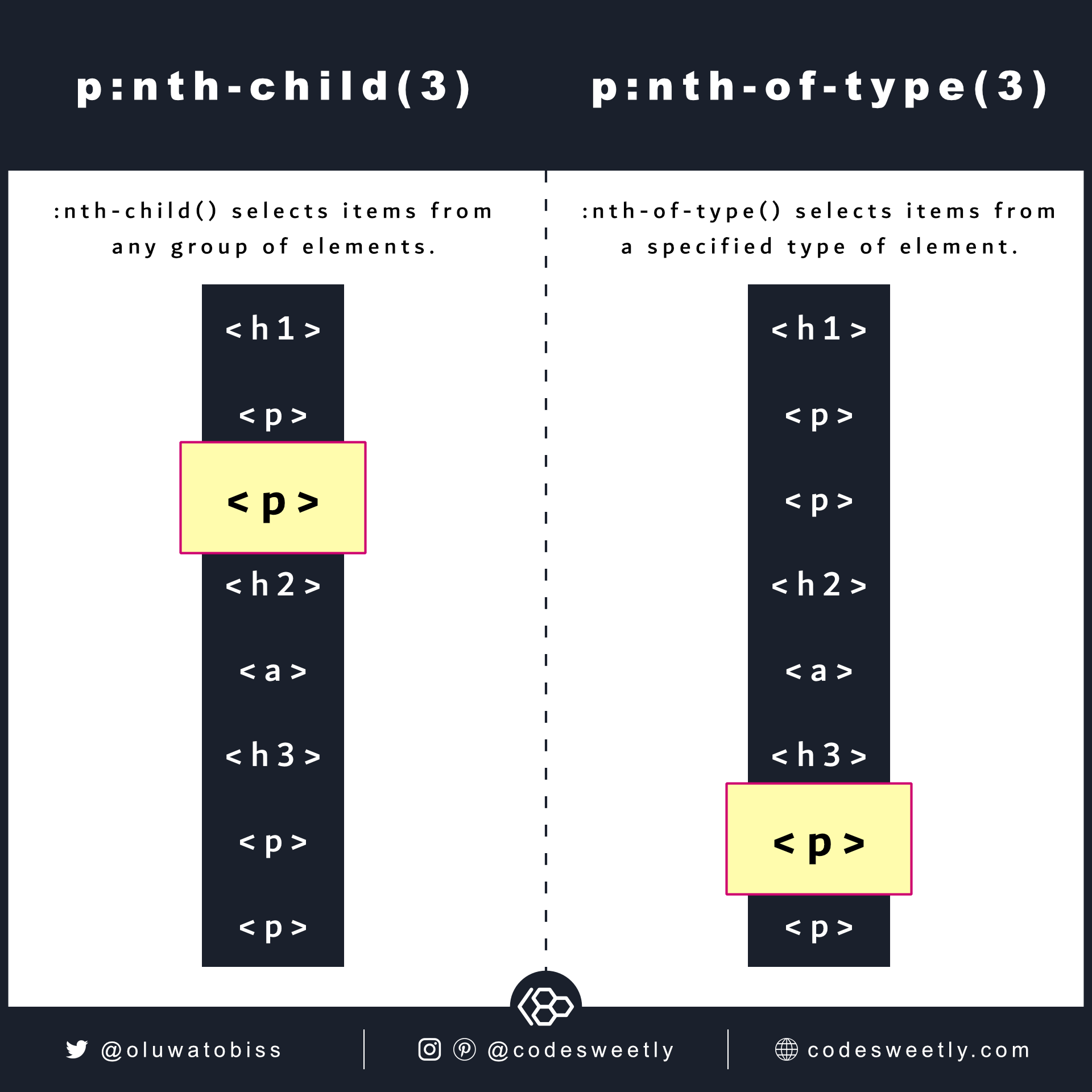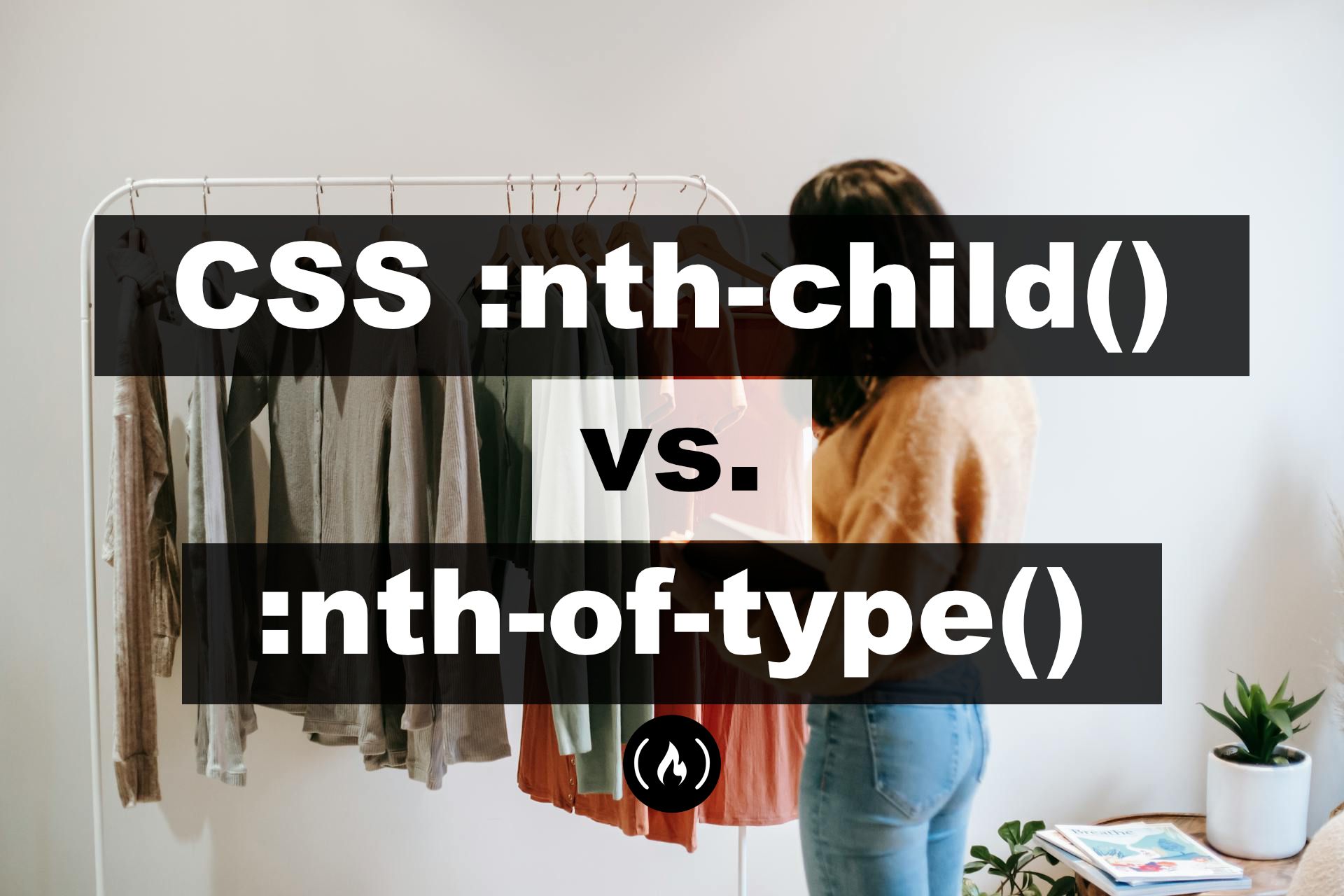The :nth-child() and :nth-of-type() CSS selectors select items from a group of HTML elements. But they work in different ways.
Here is the main distinction between them:

:nth-child()selects items from a general group of elements. For instance, selecting a<p>node from a mixed group that includes<h1>,<div>, and<section>.:nth-of-type()selects items from a specified group of elements. For instance, selecting a<p>node from a group of<p>siblings.
This article uses examples to show you exactly how the two selectors work in CSS so that you can understand their similarities and differences.
Table of Contents
So, without any further ado, let’s get started with the :nth-child() selector.
What is the CSS :nth-child() Selector?
The CSS :nth-child() selector selects one or more child elements among their direct siblings regardless of node types.
Syntax of the CSS :nth-child() Selector
The CSS :nth-child() selector accepts one argument only. Here is the syntax:
html-element:nth-child(value) {
style declarations
}The value argument can be one of the following:
- A number: For example, using
3represents the third child. - The keyword
evenorodd: We use it to represent even or odd children. - The formula
An+B: We use it to express a series of numbers. For instance,2n+3expresses these numbers:[(2x0)+3],[(2x1)+3],[(2x2)+3],[(2x3)+3], and so on.
Note the following:
:nth-child()is a CSS pseudo-class selector.- The
:nth-child()selector works on direct siblings only. - In the
An+Bformula,
Examples of the CSS :nth-child() Selector
Below are examples of how to use the CSS :nth-child() pseudo-class selector.
Apply DeepPink to the <p> element that is the third child to its parent element
The :nth-child() selector below selects the <p> element that is the third child to its parent element.
p:nth-child(3) {
color: DeepPink;
}
If the snippet below is the HTML document for the above CSS ruleset, browsers will apply DeepPink to the second <p> element only.
<h1>First heading 1 element</h1>
<p>First paragraph element</p>
<p>Second paragraph element</p>
<h2>First heading 2 element</h2>
<p>Third paragraph element</p>
<h3>First heading 3 element</h3>
<p>Fourth paragraph element</p>
<p>Fifth paragraph element</p>
The :nth-child() selector works on direct siblings only. For instance, you can re-write the HTML snippet above to include nested elements as follows:
<article>
<h1>Article's first heading 1 element</h1>
<p>Article's first paragraph element</p>
<h2>Article's first heading 2 element</h2>
<p>Article's second paragraph element</p>
<section>
<h3>Article's first heading 3 element</h3>
<p>Article's third paragraph element</p>
<p>Article's fourth paragraph element</p>
</section>
<h2>Article's second heading 2 element</h2>
<p>Article's fifth paragraph element</p>
<p>Article's sixth paragraph element</p>
</article>
The p:nth-child(3) selector will apply DeepPink only to the fourth <p> node because it is the third child of its parent element.
Apply DeepPink to every odd child that is a <p> node
The :nth-child() selector below selects every odd child element that is a <p> node.
p:nth-child(odd) {
color: DeepPink;
}
Note: 1 is the index position of the first child element.
Assuming the snippet below is the HTML document for the above CSS ruleset, browsers will apply DeepPink to the fourth <p> element only.
<h1>First heading 1 element</h1>
<p>First paragraph element</p>
<h2>First heading 2 element</h2>
<p>Second paragraph element</p>
<h3>First heading 3 element</h3>
<p>Third paragraph element</p>
<p>Fourth paragraph element</p>
Apply DeepPink to every even child that is a <p> node
The :nth-child() selector below selects every even child element that is a <p> node.
p:nth-child(even) {
color: DeepPink;
}
Note: 1 is the index position of the first child element.
Assuming the snippet below is the HTML document for the above CSS ruleset, browsers will apply DeepPink to the first, second, fourth, and sixth <p> elements.
<article>
<h1>Article's first heading 1 element</h1>
<p>Article's first paragraph element</p>
<h2>Article's first heading 2 element</h2>
<p>Article's second paragraph element</p>
<p>Article's third paragraph element</p>
<section>
<h3>Article's first heading 3 element</h3>
<p>Article's fourth paragraph element</p>
<p>Article's fifth paragraph element</p>
</section>
<h2>Article's second heading 2 element</h2>
<p>Article's sixth paragraph element</p>
<p>Article's seventh paragraph element</p>
</article>
Apply DeepPink to the third child element, seventh, eleventh, and so on that is a <p> node
The :nth-child() selector below selects every <p> child element whose index is a multiple of two (2) with an offset of three (+3).
Note: 1 is the index position of the first child element.
p:nth-child(2n+3) {
color: DeepPink;
}
Fun Quiz: If the snippet below is the HTML document for the above CSS ruleset, which of the elements will the browser style?
<p>First paragraph element</p>
<p>Second paragraph element</p>
<p>Third paragraph element</p>
<p>Fourth paragraph element</p>
<div><p>Fifth paragraph element</p></div>
<p>Sixth paragraph element</p>
<p>Seventh paragraph element</p>
<p>Eight paragraph element</p>
<div><p>Nineth paragraph element</p></div>
<p>Tenth paragraph element</p>
<p>Eleventh paragraph element</p>
<p>Twelfth paragraph element</p>
Apply DeepPink to the first child, third, fifth, and so on that is a <p> node
The :nth-child() selector below selects every <p> child element whose index is a multiple of two (2) with an offset of negative three (-3).
Note: 1 is the index position of the first child element.
p:nth-child(2n-3) {
color: DeepPink;
}
Fun Quiz: If the snippet below is the HTML document for the above CSS ruleset, which of the elements will the browser style?
<p>First paragraph element</p>
<p>Second paragraph element</p>
<p>Third paragraph element</p>
<p>Fourth paragraph element</p>
<div><p>Fifth paragraph element</p></div>
<p>Sixth paragraph element</p>
<p>Seventh paragraph element</p>
<p>Eight paragraph element</p>
<div><p>Nineth paragraph element</p></div>
<p>Tenth paragraph element</p>
<p>Eleventh paragraph element</p>
<p>Twelfth paragraph element</p>
Apply DeepPink to the <p> nodes that are one of the first three children of their parent
The :nth-child() selector below applies DeepPink to <p> nodes if they are one of their parent’s first three elements.
p:nth-child(-n+3) {
color: DeepPink;
}
Fun Quiz: If the snippet below is the HTML document for the above CSS ruleset, which of the elements will the browser style?
<article>
<h1>Article's first heading 1 element</h1>
<p>Article's first paragraph element</p>
<h2>Article's first heading 2 element</h2>
<p>Article's second paragraph element</p>
<p>Article's third paragraph element</p>
<section>
<h3>Article's first heading 3 element</h3>
<p>Article's fourth paragraph element</p>
<p>Article's fifth paragraph element</p>
</section>
<h2>Article's second heading 2 element</h2>
<p>Article's sixth paragraph element</p>
<p>Article's seventh paragraph element</p>
</article>
Note that:
1is the index position of the first child element.- The
-n+3syntax always selects the first three children because:-1 + 3 = 2-2 + 3 = 1-3 + 3 = 0
So, now that we know how the CSS :nth-child() selector works, let’s discuss :nth-of-type() so we can see the difference.
What is the CSS :nth-of-type() Selector?
The CSS :nth-of-type() selector selects one or more child elements among their direct siblings of the same node type.
Syntax of the CSS :nth-of-type() Selector
The CSS :nth-of-type() accepts one argument only. Here is the syntax:
html-element:nth-of-type(value) {
style declarations
}
The value argument can be one of the following:
- A number: For instance, using
3represents the third element type. - The keyword
evenorodd: We use it to represent even or odd element types. - The formula
An+B: We use it to express a series of numbers. For instance,2n+3expresses these numbers:[(2x0)+3],[(2x1)+3],[(2x2)+3],[(2x3)+3], and so on.
Note the following:
:nth-of-type()is a CSS pseudo-class selector.- The
:nth-of-type()selector works on direct siblings only. - In the
An+Bformula,
Examples of the CSS :nth-of-type() Selector
Below are examples of how to use the CSS :nth-of-type() pseudo-class selector.
Apply DeepPink to the third <p> element type
The :nth-of-type() selector below selects the third <p> element among its siblings of the same node type.
p:nth-of-type(3) {
color: DeepPink;
}
Assuming the snippet below is the HTML document for the above CSS ruleset, browsers will apply DeepPink to the third <p> element only.
<h1>First heading 1 element</h1>
<p>First paragraph element</p>
<p>Second paragraph element</p>
<h2>First heading 2 element</h2>
<p>Third paragraph element</p>
<h3>First heading 3 element</h3>
<p>Fourth paragraph element</p>
<p>Fifth paragraph element</p>
The :nth-of-type() selector works on direct siblings only. For instance, you can re-write the HTML snippet above to include nested elements as follows:
<article>
<h1>Article's first heading 1 element</h1>
<p> Article's first paragraph element</p>
<h2>Article's first heading 2 element</h2>
<p>Article's second paragraph element</p>
<section>
<h3>Article's first heading 3 element</h3>
<p>Article's third paragraph element</p>
<p>Article's fourth paragraph element</p>
</section>
<h2>Article's second heading 2 element</h2>
<p>Article's fifth paragraph element</p>
<p>Article's sixth paragraph element</p>
</article>
The p:nth-of-type(3) selector will apply DeepPink only to the fifth <p> node because it is the third <p> type of its parent element.
Therefore, if you add one more <p> node to the <section> element, the p:nth-of-type(3) selector will apply DeepPink to the fifth and sixth <p> items.
<article>
<h1>Article's first heading 1 element</h1>
<p> Article's first paragraph element</p>
<h2>Article's first heading 2 element</h2>
<p>Article's second paragraph element</p>
<section>
<h3>Article's first heading 3 element</h3>
<p>Article's third paragraph element</p>
<p>Article's fourth paragraph element</p>
<p>Article's fifth paragraph element</p>
</section>
<h2>Article's second heading 2 element</h2>
<p>Article's sixth paragraph element</p>
<p>Article's seventh paragraph element</p>
</article>
Apply DeepPink to every odd <p> element type
The :nth-of-type() selector below selects every <p> child element with an odd index.
p:nth-of-type(odd) {
color: DeepPink;
}
Note: 1 is the index position of the first child element.
Assuming the snippet below is the HTML document for the above CSS ruleset, browsers will apply DeepPink to the first and third <p> elements.
<h1>First heading 1 element</h1>
<p>First paragraph element</p>
<h2>First heading 2 element</h2>
<p>Second paragraph element</p>
<h3>First heading 3 element</h3>
<p>Third paragraph element</p>
<p>Fourth paragraph element</p>
Apply DeepPink to every even <p> element type
The :nth-of-type() selector below selects every <p> child element with an even index.
p:nth-of-type(even) {
color: DeepPink;
}
Note: 1 is the index position of the first child element.
Assuming the snippet below is the HTML document for the above CSS ruleset, browsers will apply DeepPink to the second, fifth, and sixth <p> elements.
<article>
<h1>Article's first heading 1 element</h1>
<p> Article's first paragraph element</p>
<h2>Article's first heading 2 element</h2>
<p>Article's second paragraph element</p>
<p>Article's third paragraph element</p>
<section>
<h3>Article's first heading 3 element</h3>
<p>Article's fourth paragraph element</p>
<p>Article's fifth paragraph element</p>
</section>
<h2>Article's second heading 2 element</h2>
<p>Article's sixth paragraph element</p>
<p>Article's seventh paragraph element</p>
</article>
Note: Browsers will apply DeepPink to the fifth paragraph because it is the second <p> node of the <section> element.
Apply DeepPink to the third <p> element type, fifth, seventh, and so on
The :nth-of-type() selector below selects every <p> child element whose index is a multiple of two (2) with an offset of three (+3).
Note: 1 is the index position of the first child element.
p:nth-of-type(2n+3) {
color: DeepPink;
}
Fun Quiz: If the snippet below is the HTML document for the above CSS ruleset, which of the elements will the browser style?
<p>First paragraph element</p>
<p>Second paragraph element</p>
<p>Third paragraph element</p>
<p>Fourth paragraph element</p>
<p>Fifth paragraph element</p>
<p>Sixth paragraph element</p>
<p>Seventh paragraph element</p>
<p>Eight paragraph element</p>
<p>Nineth paragraph element</p>
<p>Tenth paragraph element</p>
<p>Eleventh paragraph element</p>
<p>Twelfth paragraph element</p>
Apply DeepPink to the first <p> element type, third, fifth, and so on
The :nth-of-type() selector below selects every <p> child element whose index is a multiple of two (2) with an offset of negative three (-3).
Note: 1 is the index position of the first child element.
p:nth-of-type(2n-3) {
color: DeepPink;
}
Fun Quiz: If the snippet below is the HTML document for the above CSS ruleset, which of the elements will the browser style?
<p>First paragraph element</p>
<p>Second paragraph element</p>
<p>Third paragraph element</p>
<p>Fourth paragraph element</p>
<p>Fifth paragraph element</p>
<p>Sixth paragraph element</p>
<p>Seventh paragraph element</p>
<p>Eight paragraph element</p>
<p>Nineth paragraph element</p>
<p>Tenth paragraph element</p>
<p>Eleventh paragraph element</p>
<p>Twelfth paragraph element</p>
Apply DeepPink to the first three <p> element type
The :nth-of-type() selector below applies DeepPink to the first three <p> child elements.
p:nth-of-type(-n+3) {
color: DeepPink;
}
Fun Quiz: If the snippet below is the HTML document for the above CSS ruleset, which of the elements will the browser style?
<p>First paragraph element</p>
<p>Second paragraph element</p>
<p>Third paragraph element</p>
<p>Fourth paragraph element</p>
<p>Fifth paragraph element</p>
<p>Sixth paragraph element</p>
<p>Seventh paragraph element</p>
<p>Eight paragraph element</p>
<p>Nineth paragraph element</p>
<p>Tenth paragraph element</p>
<p>Eleventh paragraph element</p>
<p>Twelfth paragraph element</p>
Note:
1is the index position of the first child element.- The
-n+3syntax always selects the first three<p>child elements because:-1 + 3 = 2-2 + 3 = 1-3 + 3 = 0
Overview
In this article, we discussed the similarities and differences between the CSS :nth-child() and :nth-of-type() selectors. We also used examples to see how they work.
Thanks for reading!
And here’s a useful React.JS resource:
I wrote a book about Creating NPM Packages!
It is a beginner-friendly guidebook for mastering the art of creating, testing, and publishing NPM libraries in the React and JavaScript ecosystem.
It uses a scalable project to explain the fundamentals of building and managing NPM packages from scratch.


